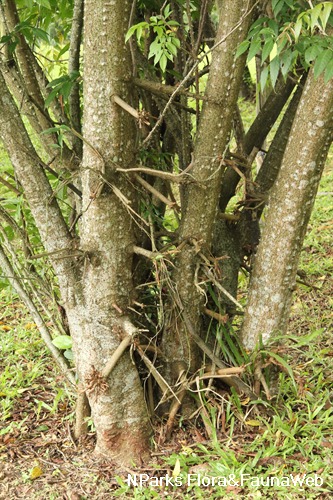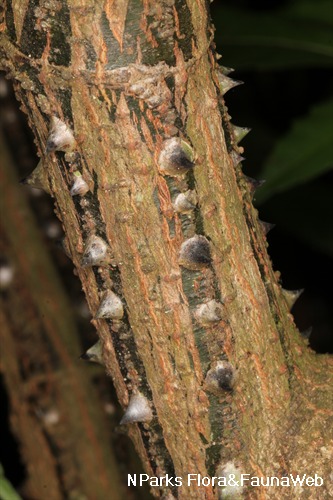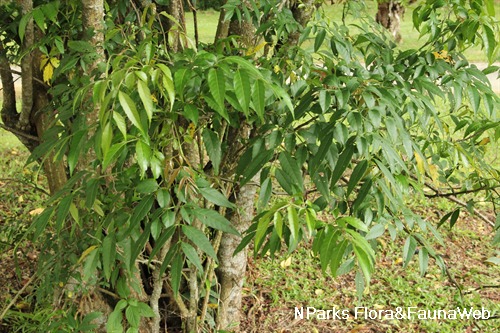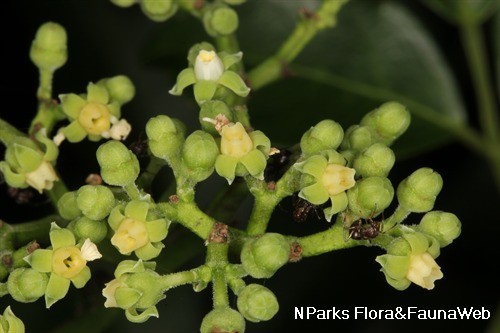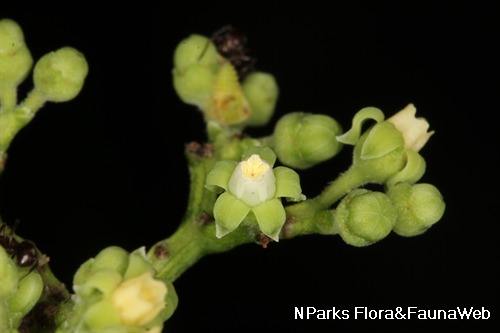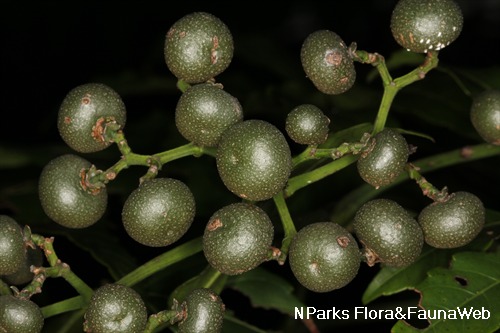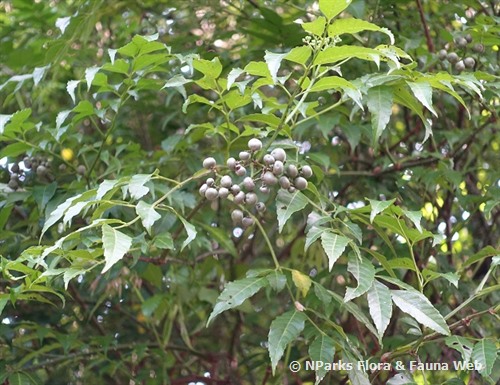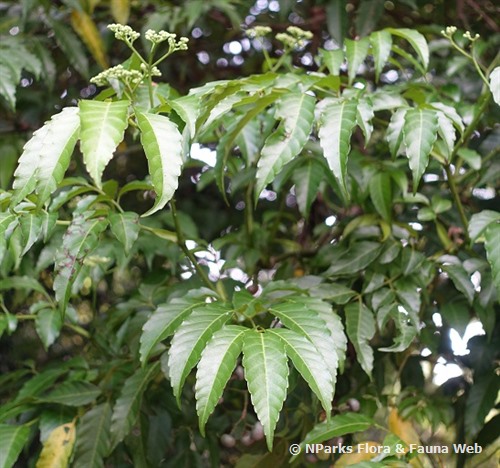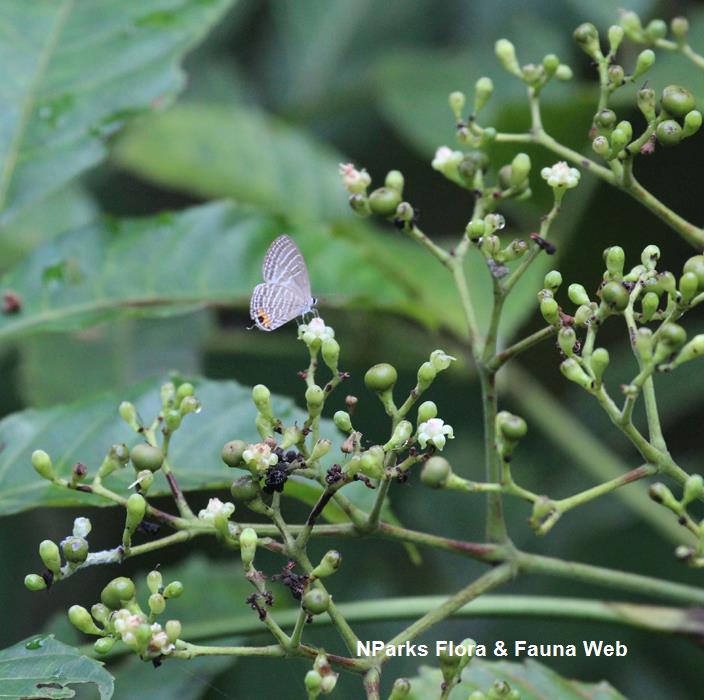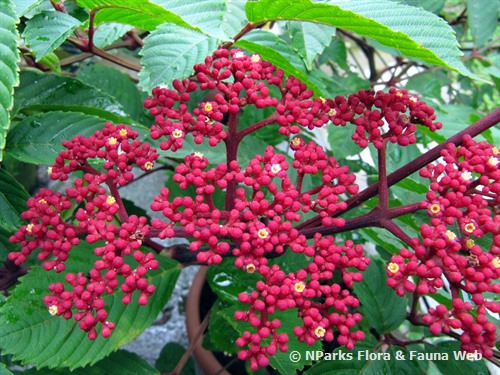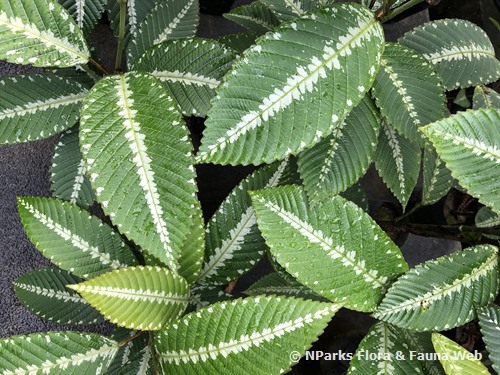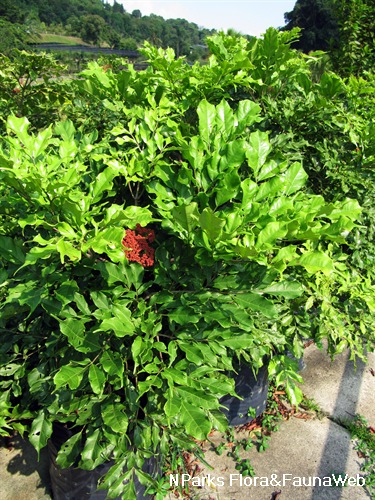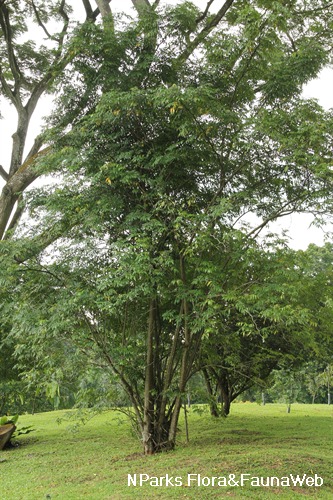
Back
Leea angulata Korth. ex Miq.
| Family Name: | Vitaceae |
| Synonyms: | Leea horrida Teijsm. & Binn., Leea sambucina var. intermedia Ridl. |
| Common Name: | Memali, Thorny Tree-Vine, Mali Berduri, Mali-Mali, Toi |
Name
Classifications and Characteristics
| Plant Division | Angiosperms (Flowering Seed Plants) (Dicotyledon) |
|---|---|
| Plant Growth Form | Tree (Small (6m-15m)), Shrub |
| Lifespan (in Singapore) | Perennial |
| Mode of Nutrition | Autotrophic |
| Plant Shape | Irregular |
| Maximum Height | 15 m |
Biogeography
| Native Distribution | Andaman Islands, Borneo, Christmas Islands, Java, Lesser Sunda Islands, Malaya, Maluku, Nicobar Islands, Philippines, Sulawesi, Sumatra, Thailand. |
|---|---|
| Native Habitat | Terrestrial (Primary Rainforest, Mountain, Secondary Rainforest, Coastal Forest, Riverine, Grassland / Savannah/ Scrubland) |
| Preferred Climate Zone | Tropical |
| Local Conservation Status | Native to Singapore (Critically Endangered (CR)) |
Description and Ethnobotany
| Growth Form | It is a shrub or a tree that grows up to 15 m tall. |
|---|---|
| Trunk | The trunk and branches are armed with thick and sharp, triangular thorns. |
| Foliage | The leaves are alternately arranged, either bipinnate or tripinnate leaves of 15-60 cm long with many leaflets. The leaves have spiny flattened petioles (leaf stalks) of 3 - 6.5 cm long. The leaflets are elliptic to ovate, measuring 7 - 10 cm long and 5 cm wide, have papery, smooth surface with serrated margins (toothed leaf edges) and dry to brown. These leaflets have cuneate base and acuminate tip. |
| Stems | This species is often multi-stemmed. |
| Flowers | Its branched flowering shoots are up to 25 cm long, 5-10 cm wide with triangular hairy bracts, measuring 3 by 2 mm. The flowers are greenish white. The pedicel is about 2 - 2.2 mm long and hairy. |
| Fruit | Its greyish blue fruit are about 7 - 10 mm in diameter, containing up to six seeds. The seed is about 5 by 3 mm. |
| Habitat | It is found along river banks, in secondary vegetation, in sandy heath and riverine forests, at up to 1500 m altitude. |
| Associated Fauna | Its flowers are pollinated by insects and butterflies. Fruit are eaten by birds. |
| Cultivation | It can be propagated by seed or stem cutting. |
| Etymology | The genus epithet Leea is named for James Lee (1715-1795), a Hammersmith nurseryman. The species epithet angulata means somewhat angled, likely referring to the angled prickles along the stem. |
Landscaping Features
| Landscaping | It is suitable for planting along streetscapes, parks and gardens, and also around edges of water as it tends to form prop roots in soft or wet soil. |
|---|---|
| Desirable Plant Features | Ornamental Fruits, Ornamental Form |
| Landscape Uses | General, Parks & Gardens, Small Gardens, Coastal, Hedge / Screening, Riverine, Flowerbed / Border |
| Usage Hazard - Cons | Spines/Thorns - Trunk, Spines/Thorns - Stem/Branch |
Fauna, Pollination and Dispersal
| Fauna Pollination Dispersal Associated Fauna | Bird-Attracting, Butterfly-Attracting |
|---|---|
| Pollination Method(s) | Biotic (Fauna) |
| Seed or Spore Dispersal | Biotic (Fauna) |
Plant Care and Propagation
| Light Preference | Full Sun, Semi-Shade |
|---|---|
| Water Preference | Lots of Water, Moderate Water |
| Plant Growth Rate | Moderate |
| Rootzone Tolerance | Moist Soils, Waterlogged Soils (Drains Site), Saline Soils / Salt Spray |
| Transplanting Tolerance | Good |
| Maintenance Requirements | Moderate |
| Potential Problems | Trunk and branches are surrounded by triangular thorns. |
| Propagation Method | Seed, Stem Cutting |
Foliar
| Foliage Retention | Evergreen |
|---|---|
| Mature Foliage Colour(s) | Green |
| Mature Foliage Texture(s) | Papery |
| Prominent Young Flush Colour(s) | Green |
| Young Flush Texture(s) | Papery |
| Foliar Type | Compound |
| Foliar Arrangement Along Stem | Alternate |
| Foliar Attachment to Stem | Petiolate |
| Foliar Shape(s) | Non-Palm Foliage |
| Foliar Venation | Pinnate / Net |
| Foliar Margin | Serrate / Toothed, Dentate |
| Foliar Apex - Tip | Acuminate |
| Foliar Base | Cuneate |
Non - Foliar and Storage
| Mature Bark Texture | Armed / Thorny |
|---|---|
| Stem Type & Modification | Thorn / Prickle |
Floral (Angiosperm)
| Flower & Plant Sexuality | Bisexual Flowers |
| Flower Colour(s) | Green, White |
|---|---|
| Flower Texture(s) | Smooth |
| Flower Grouping | Cluster / Inflorescence |
| Flower Location | Terminal |
| Flower Symmetry | Radial |
| Individual Flower Shape | Stellate / Star-shaped |
Fruit, Seed and Spore
| Mature Fruit Colour(s) | Green - Bluish Green |
|---|---|
| Fruit Classification | Simple Fruit |
| Fruit Type | Fleshy Fruit , Non-Accessory Fruit |
References
| References | <1> e-flora of Thailand. Leea angulata. Vol. 10(2):213. https://botany.dnp.go.th/eflora/floraSpecies.html?tdcode=04252 |
|---|
Image Repository
Others
| Master ID | 30061 |
|---|---|
| Species ID | 4370 |
| Flora Disclaimer | The information in this website has been compiled from reliable sources, such as reference works on medicinal plants. It is not a substitute for medical advice or treatment and NParks does not purport to provide any medical advice. Readers should always consult his/her physician before using or consuming a plant for medicinal purposes. |

